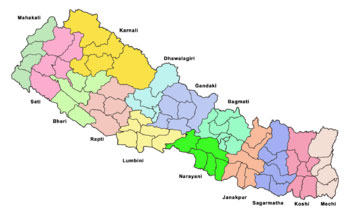

 Nepal is of roughly trapezoidal shape, 800 kilometres (500 mi) long and 200 kilometres (125 mi) wide, with an area of 147,181 square kilometres (56,827 sq mi). Nepal is commonly divided into three physiographic areas: the Mountain, Hill, and Terai Regions. These ecological belts run east-west and are bisected by Nepal's major river systems. Nepal is roughly the same size as the US state of Arkansas.
Nepal is of roughly trapezoidal shape, 800 kilometres (500 mi) long and 200 kilometres (125 mi) wide, with an area of 147,181 square kilometres (56,827 sq mi). Nepal is commonly divided into three physiographic areas: the Mountain, Hill, and Terai Regions. These ecological belts run east-west and are bisected by Nepal's major river systems. Nepal is roughly the same size as the US state of Arkansas.
The Madhesi Plains bordering India are part of the northern rim of the Indo-Gangetic plains. They were formed and are fed by three major rivers: the Kosi, the Narayani (India's Gandak River), and the Karnali. This region has a hot, humid climate.
The Hill Region (Pahad) abuts the mountains and varies from 1,000 to 4,000 metres (3,300–13,125 ft) in altitude. Two low mountain ranges, the Mahabharat Lekh and Shiwalik Range (also called the Churia Range) dominate the region. The hilly belt includes the Kathmandu Valley, the country's most fertile and urbanised area. Unlike the valleys, elevations above 2,500 metres (8,200 ft) are sparsely populated.
The Mountain Region contains the highest region in the world. The world's highest mountain, Mount Everest (Sagarmatha in Nepali) at 8,850 metres (29,035 ft) is located on the border with China. Seven more of the world's fourteen highest mountains are located in Nepal: Lhotse, Makalu, Cho Oyu, Kanchanjanga (Kanchenjunga), Dhaulagiri, Annapurna, Manaslu. Deforestation is a major problem in all regions, with resulting erosion and degradation of ecosystems.
Agriculture sustains 76% of the population and accounts for about 39% of the GDP; services comprise 41%, and industry 22%. Hilly and mountainous terrain in the northern two-thirds of the country has made the building of roads and other infrastructure difficult and expensive. There were just over 8,500 km of paved roads, and one 59 km railway line in the south in 2003. Aviation is in a better state, with 48 airports, ten of them with paved runways. There is less than one telephone per 19 people; landline services are not adequate nationwide but concentrated in cities and district headquarters; mobile telephony is in a reasonable state in most parts of the country with increased accessibility and affordability. There were around 175,000 Internet connections in 2005, but after the imposition of the "state of emergency", intermittent losses of service were reported. Uninterrupted Internet connections have resumed after the brief period of confusion as Nepal's second major people's revolution took place to overthrow the King's absolute power.
Its landlocked location and technological backwardness and the long-running civil war have also prevented Nepal from fully developing its economy. The country receives foreign aid from India, Japan, United Kingdom, United States, European Union, China, Switzerland, and Scandinavian Countries. The government's budget is about US$1.153 billion, with expenditures of $1.789bn (FY05/06). The inflation rate has dropped to 2.9% after a period of higher inflation during the 1990s. The Nepalese Rupee has been tied to the Indian Rupee at an exchange rate of 1.6 for many years. Since the loosening of exchange rate controls in the early 1990s, the black market for foreign exchange has all but disappeared. A long-standing economic agreement underpins a close relationship with India.
Until 1990, Nepal was an absolute monarchy running under the executive control of the king. Faced with a people's movement against the absolute monarchy, King Birendra, in 1990, agreed to large-scale political reforms by creating a parliamentary monarchy with the king as the head of state and a prime minister as the head of the government.
Nepal's legislature was bicameral consisting of a House of Representatives and a National Council. The House of Representatives consists of 205 members directly elected by the people. The National Council had sixty members, ten nominated by the king, thirty-five elected by the House of Representatives and the remaining fifteen elected by an electoral college made up of chairs of villages and towns. The legislature had a five-year term, but was dissolvable by the king before its term could end. All Nepalese citizens 18 years and older became eligible to vote.